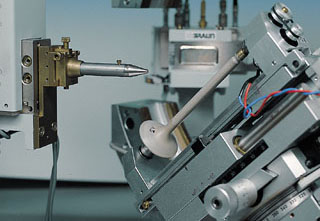Residual tension in high-performance ceramics

Process and abrasion-caused damage and residual stresses influence the edge layer hardness of ceramics. X-ray diffraction analyses and the hardness investigations adapted to the expected operational demands can provide meaningful results in these cases.
Both macroscopic residual stress, which overlays the operational stress and dislocation densities, which often are a measure for the mechanical load in processing or operation can be determined via X-ray diffraction. Surprisingly often for brittle raw material such as ceramic, because of the influence of processing procedures on the edge layer hardness, an increase in hardness due to rough processing procedures are established. X-ray determination of edge layer changes, as well as assessment using fracture mechanics show that in some cases the influence of strengthened hardness from residual stress processing exceeds the influence of process-caused damage. Similar connections are also found when considering the tribological behavior of ceramic components in the case of a preferred mechanical edge layer strain. Due to the reduced contact ratio in the run-in phase, roughly lapped services initially offer lower lubrication effects than finely lapped surfaces. The high and deep pressure residual stress induced by processing can however reduce raw material erosion over long wear paths.
Back to Assessment of Materials and Lifetime Concepts Highlights
 Fraunhofer Institute for Mechanics of Materials IWM
Fraunhofer Institute for Mechanics of Materials IWM